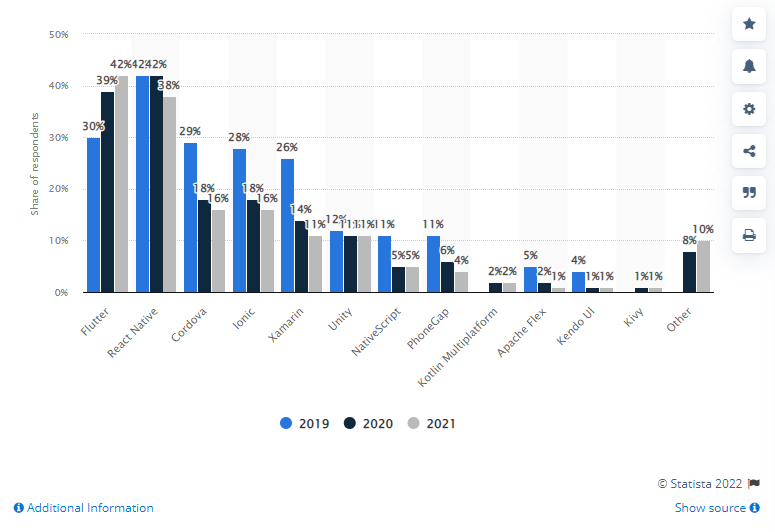The mobile app development industry continuously sees evolution. From the integration of AI and IoT to normalizing cross-platform, web apps, and hybrid apps, the segment has been improving the user experience with a dramatic speed. Now, if we talk about the cross-platform app development frameworks, we have plenty of options that might confuse inexperienced developers. But if you are experienced and have some insights into the cross-platform development industry, you might know that Flutter, React Native, and Cordova have been giving each other tough competition for more than a couple of years.

If you take these statistics by Statista into account, you can see 2019 has been an amazing year for React Native. But, by 2021, Flutter took the lead. Now, as you might have guessed which cross-platform frameworks are leading the market currently. However, we are describing them further in more detail so you can understand what makes these best cross-platform app development frameworks separate from each other. If you are curious to know more, stay with us until the end of this blog.
- React Native
Initially released in 2015, the React Native cross-platform app development framework has been the most preferred choice of developers from all over the world for many years. The open-source framework is owned by Facebook and has advantages that other frameworks do not. The framework is known for its capability of integrating native components into projects based on React to help in the development of top-notch user interfaces. Now, let’s throw some light on the crucial features that make this framework popular.
Features of React Native framework
- You can write code once and use it anywhere irrespective of apps for operating systems like Android, Windows, or iOS
- Uses JavaScript which makes it easier to use for new and experienced developers
- Huge community support has members from all over the world. So, in case you are stuck in the process of building an app, another experienced developer can rescue you
- The framework comes with UI elements that are ready to integrate with apps
2. Flutter
If you ask any iOS or Android app development company about Flutter, they will tell you hundreds of reasons for loving Flutter. The cross-platform app development framework lead the competition of these frameworks in 2021. Flutter is owned by Google and supports many operating systems like iOS, Android, Linux, macOS, Windows, and Web platforms.
Initially, Flutter was introduced as “Sky” in 2015 in the Dart Developer Summit. And the initial version that was known as Flutter came into existence in 2017. Flutter has many special features that make developers fall in love with this framework. For example, Flutter uses Dart as the only language to develop programs.
Features of Flutter framework
- Ready to integrate widgets that you can use to build high-quality interactive apps
- Hot reload option for an instant preview and feedback for new changes made to the code
- Developers just need to install IDE to start developing apps. IDE is available for all operating systems
- Apps built on Flutter are known to have lesser loading time compared to their alternatives
- Apart from having huge community support, Flutter also has Google to back it up at every stage of development
3. Cordova
Developed by Nitobi, a company owned by Adobe Systems, this framework has seen huge popularity before 2020. However, 2021 has witnessed a decline in its userbase but the framework still aces the quality of products developed on this platform. Developers can use HTML, CSS, and JavaScript content to develop apps for different platforms. To do that, Cordova renders your app in a native WebView.
Features of Cordova
- Cordova is open source and easy to use
- Prototypes can be built quickly
- Not suitable for big apps
4. Ionic
This open-source SDK was originally released in 2013. The original version of this framework was built on Angular JS and Cordova. The framework uses Cordova to allow integration of features such as camera, GPS, and Flashlight among others. Apps can be customized on Ionic for multiple platforms such as Android, iOS, and Windows among others.
Features of Ionic
- Built on technologies such as CSS, HTML, and JavaScript
- The framework is easy to learn
- APIs that are needed for using native device functions are available with JS codes
- The open-source framework is released under the MIT license
5. Xamarin
Xamarin is a treasure trove of tools that make hybrid app development much easier for developers. The framework uses C# for its operations and allows development with the support of JS libraries. Xamarin apps support three operating systems which are Android, iOS, and Windows. This framework is a brilliant pick if you want to develop apps with an authentic native look.
Features of Xamarin
- Provides native user interfaces
- Allows sharing of approximately 100% codes across all platforms
- Allows integrating backends like SAP, Microsoft Azure, and Parse
- Its applications use the .NET Base Class Library
Conclusion
Well, these were the top cross-platform mobile app development tools that you needed to know about. As you can see 2021 has been a year of change for these platforms, 2022 will see new trends emerging as well. But the real competition will remain between Flutter and React Native.
In the end, hopefully, you found this blog useful. We will see you with another blog soon. Meanwhile, keep visiting our blog to stay updated with the latest technology trends from different segments of the markets.





